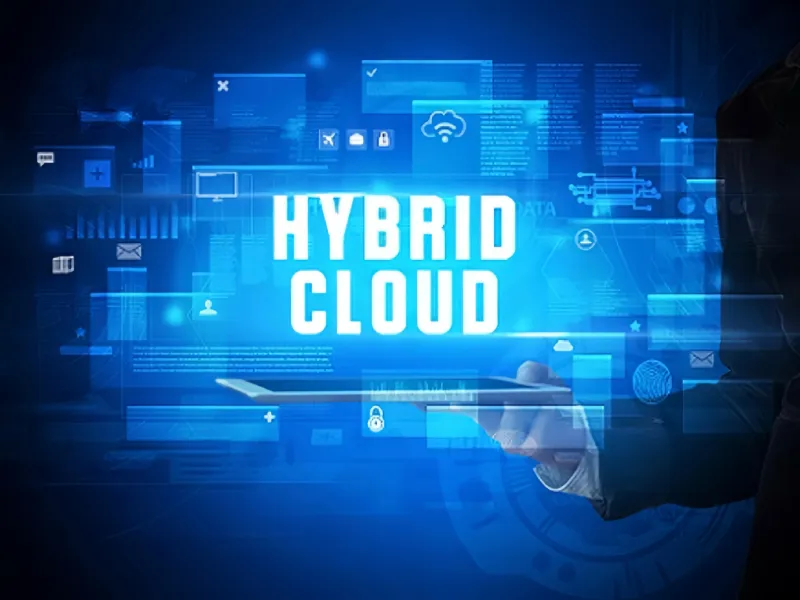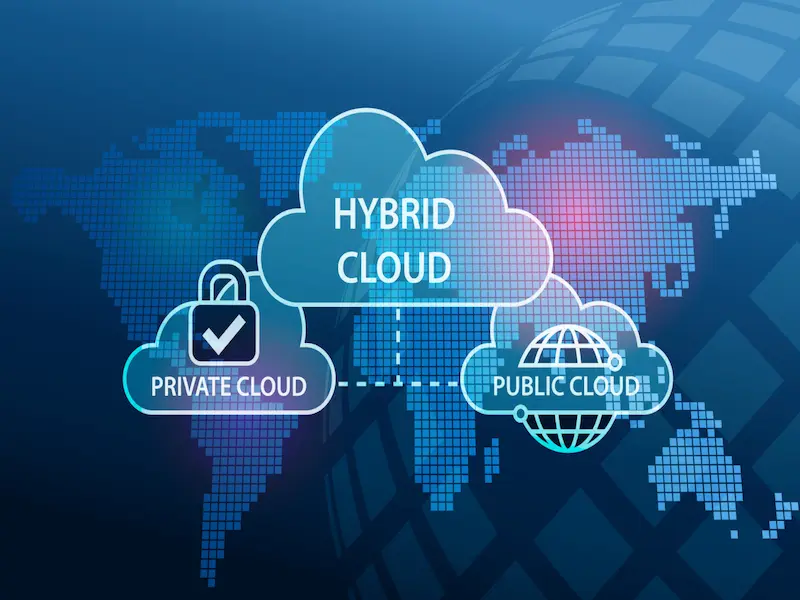- A hybrid cloud combines public and private cloud environments, allowing for flexibility in data deployment and usage. Public clouds are accessible by the general public, while private clouds are restricted to specific users, providing more controlled access and enhanced security.
- Hybrid clouds are utilised across various sectors like finance, healthcare, education, and retail, enhancing functions such as live data analysis, virtual learning, health data management, and customer-centric retail strategies. This versatility demonstrates the hybrid cloud’s capability to adapt to different industry needs.
- Notable hybrid cloud providers include AWS, Microsoft Azure, and IBM, offering tailored services that enhance business operations. Typical scenarios for hybrid cloud usage include workload management between clouds and safeguarding sensitive information, showcasing the strategic deployment of this technology.
Hybrid cloud technology combines the accessibility of public clouds with the security of private clouds, offering a versatile solution adaptable to various industries. This technology supports critical functions such as financial transactions, educational platforms, healthcare management, and retail operations. Key providers like AWS, Microsoft Azure, and IBM offer robust services that facilitate the deployment and management of applications across both cloud types. Hybrid clouds are particularly valuable for managing sensitive data and handling fluctuating workloads, enabling businesses to optimise their operations while maintaining data security and operational flexibility.
Also read: Understanding the hybrid cloud deployment model
Also read: What is hybrid cloud migration?
What is hybrid cloud?
Hybrid cloud refers to an IT architecture that combines private cloud, public cloud, and on-premises resources to provide greater flexibility and efficiency. This model allows businesses to maintain sensitive workloads in a secure private cloud or on-premises data center while leveraging the scalability and cost-effectiveness of public cloud services for less sensitive operations.
The key advantage of hybrid cloud lies in its ability to integrate multiple environments seamlessly, enabling organizations to optimize their IT resources according to specific needs. By adopting a hybrid cloud strategy, companies can achieve a balanced approach that enhances performance, scalability, and cost-efficiency.
Also read: Edge computing vs. cloud computing: Essential contrasts

Benefits of hybrid cloud
1. Flexibility and Scalability
One of the most prominent benefits of hybrid cloud is its flexibility. Businesses can scale their operations dynamically, utilizing public cloud resources during peak demands and scaling down when those resources are no longer needed. This elasticity allows organizations to avoid over-provisioning resources and reduces costs significantly.
For instance, an e-commerce company might experience spikes in traffic during holiday seasons. A hybrid cloud setup enables the company to accommodate increased demand by leveraging public cloud resources while maintaining a stable, private environment for critical customer data.
2. Cost Optimization
By combining private and public cloud environments, hybrid cloud allows organizations to optimize their spending. Businesses can keep sensitive or compliance-heavy data on-premises or in a private cloud, where they have full control, while taking advantage of the cost-efficient nature of public cloud services for less critical tasks.
3. Improved Security and Compliance
Hybrid cloud architectures provide enhanced security by allowing organizations to store sensitive data in private environments with controlled access. This is particularly important for industries like healthcare, finance, and legal services, where compliance with regulations such as GDPR or HIPAA is essential.
Organizations can also implement robust disaster recovery strategies, ensuring that critical data remains secure and accessible even in the event of a system failure. By utilizing a hybrid approach, businesses can protect their most valuable assets while still benefiting from the advantages of public cloud solutions.

4. Enhanced Performance
With hybrid cloud, businesses can optimize workload placement to ensure peak performance. Applications with low latency requirements can be hosted on private servers, while less time-sensitive operations can be deployed in the public cloud. This strategic placement reduces bottlenecks and improves overall system efficiency.
5. Business Continuity
A hybrid cloud approach ensures that businesses can maintain continuity even during unexpected disruptions. With the ability to shift workloads between private and public environments, organizations can quickly recover from outages, minimizing downtime and potential revenue losses.
Also read: ViewQwest and Console Connect revolutionise cloud connectivity for Singapore enterprises
Challenges of hybrid cloud
While hybrid cloud offers numerous benefits, it’s not without challenges. Implementing and managing a hybrid environment requires careful planning, robust governance, and ongoing maintenance.
1. Complexity in Management: Managing a hybrid cloud infrastructure can be complex, especially when integrating multiple environments. Organizations must ensure that all components work seamlessly together, which often requires advanced tools and expertise.
2. Security Concerns: While hybrid cloud enhances security for sensitive workloads, it also introduces potential vulnerabilities. Ensuring data protection across both private and public environments requires robust encryption, identity management, and compliance measures.
3. Cost Overruns: Although hybrid cloud can optimize costs, poor management of resources can lead to overruns. Businesses need to monitor and control their usage of public cloud services to avoid unexpected expenses.
4. Integration Issues: Seamless integration between on-premises, private cloud, and public cloud environments is essential for a successful hybrid strategy. Compatibility issues can arise, particularly when dealing with legacy systems or diverse vendor solutions.
5. Skill Gap: Deploying and managing hybrid cloud environments requires skilled IT professionals. Organizations may need to invest in training or hire experts to ensure that their hybrid cloud strategy is executed effectively.
Also read: The hybrid cloud’s potential for business efficiency and security
Also read: Navigating the hybrid cloud: Maximising flexibility and security
In today’s business world, every company needs to leverage the cloud. Hybrid solutions provide the best of both worlds for innovation and security.
Jeff Bezos, Founder of Amazon
How to overcome hybrid cloud challenges
Overcoming the challenges of hybrid cloud involves implementing best practices and leveraging advanced tools and services. Here are some tips:
1. Invest in Cloud Management Platforms
Cloud management platforms can help streamline operations by providing a centralized interface for managing hybrid environments. These tools enable IT teams to monitor performance, control costs, and enforce security policies effectively.
2. Adopt Zero Trust Security
Zero Trust security models ensure that every user and device is verified before accessing resources. This approach enhances security by minimizing the risk of unauthorized access in a hybrid environment.
3. Plan for Scalability
Organizations should design their hybrid cloud infrastructure with scalability in mind. By anticipating growth and potential changes in workload demands, businesses can avoid costly upgrades or migrations down the line.

4. Ensure Compliance
Compliance with industry regulations is critical in a hybrid cloud setup. Businesses should regularly audit their environments and implement controls to meet standards such as GDPR, HIPAA, or SOC 2.
5. Invest in Training
Closing the skill gap is essential for successful hybrid cloud deployment. Investing in training programs or hiring certified professionals can ensure that teams have the expertise needed to manage complex infrastructures.
Hybrid cloud use cases
Hybrid cloud is being adopted across industries to solve unique challenges and drive innovation. Here are some notable use cases:
1. Healthcare: The healthcare industry uses hybrid cloud to manage sensitive patient data securely while leveraging public cloud services for data analytics and research. This approach ensures compliance with strict regulations while enabling advancements in medical research.
2. Financial Services: Banks and financial institutions benefit from hybrid cloud by hosting critical operations in private environments and using public cloud services for customer-facing applications. This model improves security while enabling rapid innovation.
3. Retail: Retail businesses use hybrid cloud to handle seasonal spikes in demand. By combining private cloud for inventory management and public cloud for customer-facing applications, retailers can enhance performance and customer satisfaction.
4. Education: Educational institutions adopt hybrid cloud to provide online learning platforms while maintaining secure systems for student data. This setup ensures reliability and scalability, especially during peak usage periods.
The hybrid cloud is the new normal. Enterprises need flexibility and the ability to innovate anywhere.
Satya Nadella, CEO of Microsoft
The future of hybrid cloud
The hybrid cloud landscape continues to evolve as businesses seek more efficient ways to manage workloads. Emerging technologies such as edge computing, artificial intelligence, and machine learning are set to enhance the capabilities of hybrid cloud environments.
Edge computing, for example, complements hybrid cloud by enabling real-time data processing closer to the source. This reduces latency and improves the performance of applications, particularly in industries like IoT and autonomous vehicles.
Artificial intelligence and machine learning tools are also transforming hybrid cloud by automating resource allocation, optimizing workloads, and enhancing security measures. As these technologies advance, they will further simplify the management of hybrid environments and unlock new opportunities for innovation.
Also read: The future of cloud computing: Exploring hybrid cloud

Embracing hybrid cloud
Hybrid cloud represents a transformative solution for businesses striving to achieve flexibility, scalability, and cost efficiency in their IT infrastructure. By integrating private and public cloud environments, organizations gain the ability to optimize resources, improve performance, and reduce operational costs. This approach is particularly beneficial in industries with fluctuating demands, such as retail, healthcare, and finance, where scalability and secure data management are paramount.
Despite its advantages, implementing hybrid cloud comes with challenges, including complexities in integration, potential security vulnerabilities, and the need for skilled personnel to manage the environment effectively. However, these obstacles can be addressed through strategic planning, investment in advanced management tools, and training initiatives to bridge skill gaps within IT teams.
The hybrid cloud model allows businesses to tailor their infrastructure to specific needs, placing critical workloads in secure private environments while leveraging the public cloud for scalability and cost-effectiveness. This strategic balance not only enhances operational efficiency but also ensures business continuity and resilience in the face of disruptions.
By adopting a hybrid cloud strategy, organizations can unlock the full potential of their IT systems, enabling innovation, agility, and competitiveness in an increasingly dynamic digital landscape. The future of enterprise success lies in embracing the hybrid cloud\u2019s powerful capabilities.
FAQs: Understanding hybrid cloud
Hybrid cloud is an IT architecture that combines private cloud, public cloud, and on-premises infrastructure to deliver flexibility, scalability, and security. It allows businesses to manage sensitive workloads in a private environment while utilizing public cloud resources for non-critical tasks, ensuring optimal resource utilization.
The main benefits include flexibility, scalability, cost optimization, improved security, and enhanced performance. Organizations can scale resources as needed, reduce operational costs, and ensure secure management of sensitive data while maintaining business continuity during disruptions.
Common challenges include managing complexity, ensuring security, avoiding cost overruns, integrating diverse systems, and addressing skill gaps in IT teams. These can be mitigated with proper planning, robust management tools, and ongoing training.
Hybrid cloud integrates private and public cloud environments into a single, cohesive system, allowing seamless workload movement. Multi-cloud, on the other hand, involves using multiple cloud services from different providers without necessarily integrating them into a unified infrastructure.
Industries like healthcare, finance, retail, and education benefit significantly from hybrid cloud setups. These sectors rely on secure data management, scalability for peak demand, compliance with regulations, and robust performance to meet their specific operational needs.
